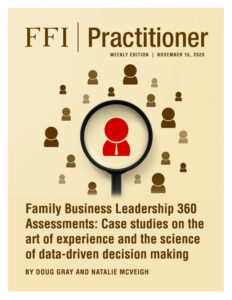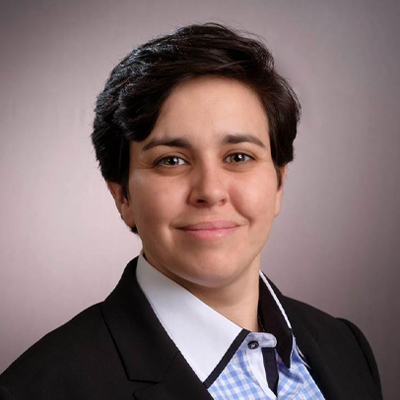
View this edition in our enhanced digital edition format with supporting visual insight and information.
Thanks to Doug Gray and FFI Fellow Natalie McVeigh for providing two case studies about how they utilize 360 assessments to provide comprehensive and objective feedback to family business leaders and to evaluate potential next generation successors.
A common problem facing senior-generation owners in multi-generational enterprises is how to objectively assess the capabilities and capacity of next-generation family employees and leaders. Some owners are facing decisions about which next-gen family member will be the most capable successor. Others may also be seeking to determine if a non-family member may be a better option. Still others may be focused on learning how to develop all members of the next generation, and don’t yet know what core competencies to require or which behaviors to encourage. All too often, these dilemmas result in ongoing sleepless nights for family enterprise owners.
A second, and related, common problem is that potential leaders in the next generation, whether in their twenties or fifties, do not know how to demonstrate their capacity to the senior generation. As one client said, “I just don’t know how to prove to my father that I am ready to take over.” Sometimes, the rising generation adopts a variation of the “patient capital” model—waiting for years and enduring too many sleepless nights.
Although effective advisors assess strengths and gaps of potential successors, recommend succession options, and serve the broader family needs, these advisors could still benefit from the using the intersection of these two common problems to practice both the art of experience and the science of data-driven decision making.
Family Business Leadership Assessment Tools
There are countless validated assessment tools that may be useful for leadership development or for identifying family business strengths, weaknesses, blind spots, and hidden strengths.
Here are some questions to consider before choosing an assessment tool to use with a client:
- Is it designed to describe a theory or model?
- Is it designed for academic or business application?
- What evidence exists to show how the assessment tool can impact business results?
- What is the data set that the assessment tool has been normed against?
- What are the measures of reliability and validity?
A 360-degree assessment, when implemented correctly, is an effective performance feedback process used by organizational development psychologists.1 A 360 is a way for multiple individuals with different perspectives to share feedback with colleagues related to their skills, performances, and leadership style. Below is one example of a 360-degree assessment tool that can be useful when consulting with next-generation family enterprise leaders, that recognizes the complexity of family enterprises and the need for individual fit within a diverse set of systems including the family, ownership, business, and learning systems.
Example: The Assess Next GenTM 360 Leadership Process

Figure 1: The Assess Next GenTM 360 Leadership Process2
The Assess Next GenTM 360 Leadership Process3 includes the following steps. The leader initiates the feedback process, selecting at least thirteen raters and inviting them to participate. In a family enterprise context, the raters may have multiple roles, e.g., one person may be an owner and a manager. This 360 assessment process includes seven rater groups and a hierarchy that reflects the complexity in many family enterprises. Those seven rater groups include owners, board members, managers, peers, direct reports, family/friends, and the self-rater. To provide anonymity, there are typically at least three raters in each rater group. The consultant maintains confidentiality and provides feedback directly to the leader, not to the owner(s). Each leader’s evaluation process typically takes eight weeks. The feedback results are both quantitative (using high and low scores, as well as the differences between others’ ratings and self-ratings) and qualitative (using verbatim comments and behavioral interviews). This feedback is then shared with each leader, who then works collaboratively with the advisor to create a corresponding development plan.
Here are two mini-case studies describing examples of a process that we have used with multiple family business leaders across a variety of sectors.
Individual Case Study
Natalie had a new family business executive coaching client for whom she wanted to provide validated 360 feedback to support the possibility of her client’s succession as the next-gen leader. Specifically, she wanted to assess the perceived leadership effectiveness of her client, beyond the anecdotal feedback from others and beyond the client’s self-report. To encourage the client organization’s participation in the assessments and to model how family and non-family members could provide feedback to one another, she needed to engage with family members who had never provided direct feedback to one another. Utilizing a methodical 360-assessment process and feedback sessions with the client, Natalie was able to increase family harmony, improve the quality of direct communication among family members, and validate that the client was well respected and perceived as capable of serving as the next-gen successor. By integrating the feedback received from diverse participants, Natalie provided specific behavioral directions for the next-gen leader, making the assessment a turning point for the family to improve their communication.
Team Case Study
Doug had worked for eighteen months with a mid-management team of five in a fast-growing company. The team was preparing for a year of transition, with the non-family president and CFO moving into newly created board roles. The owner and executive leadership team requested a 360-leadership development assessment process for all five members of the leadership team to be completed within two months. Because two of the client leaders were family and three were non-family leaders, Doug used two different versions of the Assess Next GenTM 360 Leadership Assessment process.
The results provided specific behavioral feedback that quickly brought value to both individuals and the organization. One leader was re-assigned to support new market needs. Three leaders were given new titles and compensation increases. About half of the workforce (seventy raters) participated in the 360 assessment by providing confidential feedback, which included both quantitative and qualitative data. The quantitative data included a thirty-two-page PDF report that ranked fifty behaviors by scores, five systems (family, business, ownership, learning, and individual), and data visualization graphs that identified strengths, weaknesses, blind spots/derailers and hidden strengths/talents. The most detailed data summary provided scores and gaps from each of the seven rater groups (owners, board, managers, peers, direct reports, family/friends, and self) for those fifty behaviors. The leader received each rater group’s anonymized feedback, which identified key directions and intensity of calls for behavior change. For example, if the leader’s direct reports identified a gap in behavior, that could indicate to the leader to focus on that behavior immediately. The result for the advisor is a road map for individual development work in the next twelve months.
Doug also provided each leader with detailed qualitative feedback. He invited all of the raters to short interviews where he asked, “What should this leader start doing, stop doing, and continue doing?” In addition, those three questions were included in the digital survey and in a separate PDF report that was not shared directly with the leader. (One lesson learned from earlier research is that family business leaders were not familiar with the need to provide feedback in a professional manner. Since some participants choose to vent and write critical comments, the qualitative feedback report is now compiled separately and provided to the advisor, not directly to the leader.) After studying the written data and his interview notes, Doug summarized that qualitative data in a detailed video summary on behaviors for that leader to start, stop, or continue doing. In their one-on-one coaching sessions, each leader turned the quantitative and qualitative feedback into action plans. To close the performance feedback loop, each leader developed and shared their improvement plans with their managers. Lastly, each leader sent an email to thank their raters and to indicate the behaviors they intend to start, stop, and continue.
The owner and executive leadership team respected the confidential design of this performance feedback process and asked only for an executive summary. Doug’s feedback session included a short written summary, the number of raters, and the summary of key behavioral strengths, weaknesses, and gaps. Perhaps the most significant outcome was that all participants in this assessment process—owners, raters, and leaders—learned that they had a voice and opportunities to accelerate a strategic performance feedback process within their family business.
Closing Thoughts
The consultative process is as important as the content, and advisors must work closely with the leader and the family enterprise. Along these lines, advisors can benefit from integrating rigorous 360 assessments to help provide comprehensive analysis of potential leaders in the next generation.4 When utilized properly, this leadership assessment process can provide invaluable direction for the advisor, deep behavioral insight for the owners, models performance feedback and organizational change, and clarifies required behaviors for any decision-makers included in this process.
References
1 Church, A.A., Bracken, D.W., Fleenor, J.W., & Rose, D.S. (Eds.). (2019). The Handbook of Strategic 360 Feedback. Oxford University Press.
2 Adapted from Nieto-Rodriguez, A. (2021). The Project Economy Has Arrived. Harvard Business Review. Reprint R2106.
3 See www.AssessNextGen.com
4 Gray, D.W. (2021, April 6). Distributed Ownership Tips for Family Businesses. The Family Business Consulting Group. https://www.thefbcg.com/resource/distributed-ownership-tips-for-family-businesses/
About the Contributors

Doug Gray, PhD, PCC, is a consultant with the Family Business Consulting Group, co-founder of Assess Next Gen, LLC, an author, speaker, researcher, next-gen advocate, and FFI member. He can be reached at [email protected].

Natalie McVeigh, FFI Fellow, is a consultant and coach with EisnerAmper in their Center for Individual and Organizational Performance. In addition to her work with clients and teaching, she is the chair of FFI’s Global 9 Virtual Study Group and is a former member of FFI’s Board of Directors. Natalie is also a member of the GEN faculty. She can be reached at [email protected].

View this edition in our enhanced digital edition format with supporting visual insight and information.





